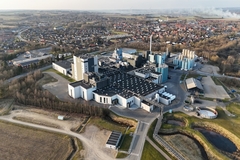
- Industry news
Industry news
- Category news
Category news
- Reports
- Key trends
- Multimedia
- Journal
- Events
- Suppliers
- Home
- Industry news
Industry news
- Category news
Category news
- Reports
- Key trends
- Multimedia
- Events
- Suppliers
Impossible Whopper lifts Burger King traffic in US, Barclays data reveals

18 Oct 2019 --- Burger King’s unveiling of The Impossible Whopper is driving traffic to the fast food chain, according to Barclays analysts. In April, Burger King became a non-meat platform pioneer, testing the Impossible Whopper in 59 St. Louis restaurants before rolling out the meatless burger across US restaurants in August. Now, Barclays data teams have analyzed geolocation data to assess the impact surrounding the test and the national launch. It reveals the preliminary trial generated up to 18 percent gains in the St. Louis locations versus no comparable gains for McDonald’s St. Louis restaurants. And, Burger King has seen a 2 percentage point traffic boost nationally versus McDonald’s with indications that gains have been sustained through to the end of the quarter, according to the analysis.

This does not imply that McDonald’s lost traffic directly to Burger King, stresses the research, but instead that McDonald’s is a control baseline for the product launch. “The elevated traffic share has been sustained since the launch, though the traffic boost has moderated from its peak, with the ultimate settling point still to be determined,” says the data. And while the data certainly points to the fact that the Impossible Whopper led this increase in traffic, causality cannot be determined.
The big three Quick Service Restaurant (QSR) burger players in the US (McDonald’s, Burger King & Wendy’s) are perpetually battling each other for market share. To put the Impossible Whopper traffic gains in context, the Barclays Data teams compared the traffic trends of Burger King and McDonald’s in St. Louis and found that the Impossible Whopper drove an approximately 5-10 percent improvement in Burger King traffic nationally relative to McDonald’s over the same time period.
The Impossible Whopper sandwich, Impossible Foods’ meatless patty, features the same burger build as the store’s traditional beef-based option, featuring tomatoes, lettuce, mayonnaise, pickles and sliced white onions on a sesame seed bun.
The heme in the Impossible Burger, which comes from its use of soy leghemoglobin, replicates the essential heme that humans have been consuming for hundreds of thousands of years in meat. While the Impossible Burger delivers all the craveable depth of beef, it uses far fewer resources because it’s made from plants, not animals.
Burger King altered the US QSR burger landscape through the Impossible Whopper pilot and subsequent national launch. While McDonald’s has had meatless burgers such as the McVegan (vegan soybean steak burger) in Europe for a couple of years (launched in Finland & Sweden in 2017), the world’s largest burger chain has yet to launch a meatless burger in the US (though it is now testing one in Canada), notes Barclays.
“On Burger King’s Impossible Whopper, investors have two primary questions: How big of a company lift did it provide? Is this sustainable over time? Barclays Investment Sciences and Data Science teams believe that using geolocation data to measure traffic can provide unique insights into these questions.”
“We think the best approach is to look at how relative traffic share has evolved between restaurants where the Impossible Whopper was sold, and control groups – other locations of the same restaurant, or other restaurants, where the Impossible was not available,” says the report.
Despite the improvements in traffic potentially generated by the introduction of the burger, the Impossible Whopper traffic benefits moderated (& ultimately turned negative) two months later before receiving a second boost (and returning positive) surrounding the nationwide launch on August 8.
Plant-based gaining traction and grabbing attention
Global meat alternatives have moved far beyond the niche vegetarian and vegan domain to encompass a much broader base of flexitarians, as the quality improves to replicate real meat. According to data from Innova Market Insights, meat substitutes accounted for 11 percent of new meat product launches (meat, poultry and meat substitutes) reported in Europe in 2018 (Jan-Sep), up from 9 percent in 2013. The global picture shows stronger growth still, with 14 percent of meat launches in the first nine months of 2018 being meat alternatives. This compares with 6 percent in 2013.
As consumers reduce their meat intake, food companies are rushing to compete with plant-based alternatives.
The US appetite for meat alternatives is also growing as highlights in an Innova Market Research survey revealing that one in five US consumers “have eaten less meat across the past year.”
In August, soy leghemoglobin was approved as a color additive to be used in uncooked ground beef analog products following a petition from Impossible Foods in 2018. The US Food and Drug Administration’s (FDA) green light means the company is allowed to sell raw Impossible burger directly to consumers, instead of cooked via restaurants, prompting further growth in the meatless space.
However, following the approval, the Center for Science in the Public Interest (CSPI) launched a rebuttal that branded the approval as “barebones.” The response brought to the fore critics’ concerns over the potential health impacts of certain ingredients being used in products that are attempting to replicate meant - sans animal-based ingredients.
Last month, Impossible Foods entered the retail market with the rollout of its 2.0 plant-based meats across 27 Gelson’s Markets in Southern California, US. East Coast expansion is expected soon, with Impossible Foods planning to be available in grocery stores across every region of the US by mid-2020.
By Gaynor Selby










